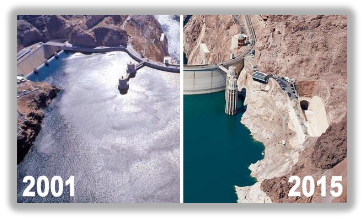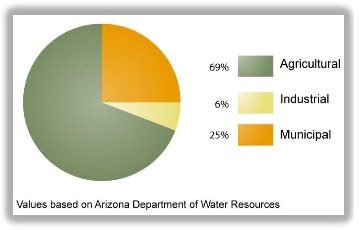Millions of people rely on the Colorado River Basin for water. They come from diverse backgrounds and lead unique lives, but they are bound together by their reliance on the basin to meet their basic human needs. It is unclear if the basin will be able to adequately meet those needs in the future. Climate change is predicted to increase the frequency and severity of drought in the basin and the current drought is causing people to look for solutions that will decrease water demand.
Water Cutbacks
Colorado River Basin buffers humans against the effects of drought by supplying water to two reservoirs. However, the buffering ability is being stretched to the limit. Since 2000, the basin has experienced the driest period ever seen in the last 100 years.
Prolonged periods of low rainfall stress the system and require humans to cut back on water use. Currently, water cutbacks are voluntary, but water levels are nearing the point where mandatory water cutbacks will kick in and affect Arizona, Nevada, and New Mexico. Mandatory cutbacks will begin if the water levels in Lake Mead drop below 1,075 ft. In the summer of 2017, the water level of Lake Mean dropped down to 1079ft, coming dangerously close to the water level when mandatory cutbacks would be enacted. The burden of mandatory cutbacks will fall most heavy on Arizona, which receives about 40% of its water from the Colorado River Basin.

Although Lake Mead is close to the level that will cause mandatory water restrictions, Arizona is not in a water crisis. The current water shortage and the mandatory restrictions are not expected to have short-term effects on Arizona residents or local tribes. It is the state’s agricultural sector that will be most immediately and intensely feel the effect of water restrictions.
Arizona Agriculture
Water flowing to Arizona supports the state’s 900,000 acres of agricultural land. This water makes up 70% of Arizona’s total water use. The agricultural industry is dominated by cattle, citrus, and cotton. All three require large amounts of water. If current trends in agriculture and precipitation continue, the average economic damage in the Rio Grande Basin due to reduced water inflow to agriculture is estimated at $100 per acre foot. These costs could be extremely damaging to Arizona’s economy.

Tough Decisions
To head off possible damaging effects of water shortage, Arizona is exploring voluntary cutbacks and ways to increase water storage. Many of the voluntary programs are focused on the agricultural sector. The state offers an incentive program for farmers who adopt techniques to improve their water efficiency. Farmers have begun to switch from water intensive crops, like citrus and cotton, to crops that require less water, like durum wheat. Switching to less water intensive crops has the dual benefit of requiring less water while increasing crop yields in dry years. However, making this change can be a difficult decision for a farmer.
Farming requires a lot of knowledge and monetary investment. Switching to a different kind of crop can hit a farmer’s wallet hard. Investing in a new crop may require new equipment and cultivating crops that have a lower market value because there is less demand. Additionally, many farmers have developed routines and subtle knowledge about how to maximize the yield for their current crop. The farmers may not be ready to throw away those routines and the knowledge that they built up over the years. It can take many years to learn how to grow a new type of crop. These years of trial and error can be frustrating and costly.
There is also the issue of how feasible it is to replace a crop. Annual crops like cotton, which need to be removed every year, can be replace in between growing seasons. However, farmers growing citrus trees face the difficult decision of whether to remove trees that they have maintained and nurtured over the course of many years. The trees represent a significant investment in time and money, which a farmer may be reticent to abandon.
Rather than switch to less thirsty crops, some farmers are considering the use of groundwater to meet their irrigation needs. Pumping groundwater means that the farmers will be less reliant on inflow from the Colorado River Basin. While this decision can have short-term benefits, it could be costly in the long- run. Large-scale ground water pumping has the potential to deplete underground aquifers. As the water level goes down in the aquifer, the land will start to sink. This could change the hydrology of the entire farming area.
Necessary Action
There is no single solution that will ease Arizona agriculture’s demand for water from the Colorado River Basin. It will take a combination of increasing water efficiency, switching to less thirsty crops, and exploring other sources of water. Each of these potential solutions comes with its own cost to individuals or the environment. Taking action will be difficult, but it is necessary if Arizona wants to avoid mandatory water restrictions.
